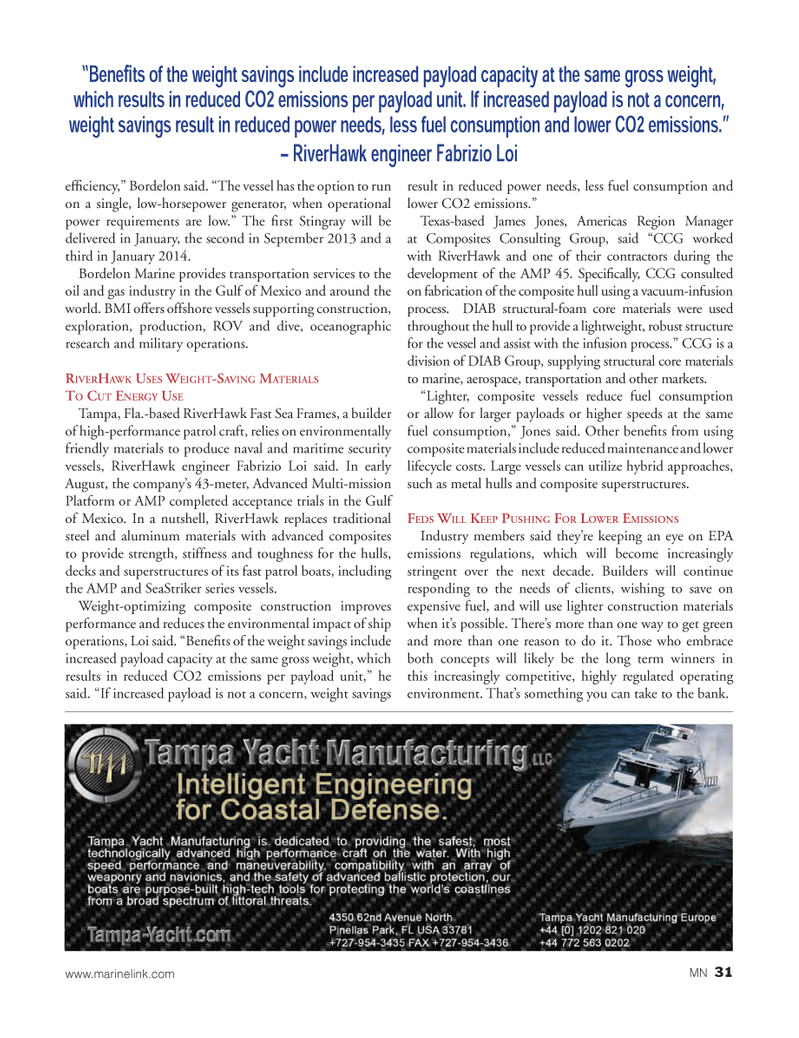
Page 31: of Marine News Magazine (September 2012)
Environment: Stewardship & Compliance
Read this page in Pdf, Flash or Html5 edition of September 2012 Marine News Magazine
efÞ ciency,Ó Bordelon said. ÒThe vessel has the option to run on a single, low-horsepower generator, when operational power requirements are low.Ó The Þ rst Stingray will be delivered in January, the second in September 2013 and a third in January 2014. Bordelon Marine provides transportation services to the oil and gas industry in the Gulf of Mexico and around the world. BMI offers offshore vessels supporting construction, exploration, production, ROV and dive, oceanographic research and military operations. RIVERHAWK USES WEIGHT-SAVING MATERIALS TO CUT ENERGY USE Tampa, Fla.-based RiverHawk Fast Sea Frames, a builder of high-performance patrol craft, relies on environmentally friendly materials to produce naval and maritime security vessels, RiverHawk engineer Fabrizio Loi said. In early August, the companyÕs 43-meter, Advanced Multi-mission Platform or AMP completed acceptance trials in the Gulf of Mexico. In a nutshell, RiverHawk replaces traditional steel and aluminum materials with advanced composites to provide strength, stiffness and toughness for the hulls, decks and superstructures of its fast patrol boats, including the AMP and SeaStriker series vessels. Weight-optimizing composite construction improves performance and reduces the environmental impact of ship operations, Loi said. ÒBeneÞ ts of the weight savings include increased payload capacity at the same gross weight, which results in reduced CO2 emissions per payload unit,Ó he said. ÒIf increased payload is not a concern, weight savings result in reduced power needs, less fuel consumption and lower CO2 emissions.Ó Texas-based James Jones, Americas Region Manager at Composites Consulting Group, said ÒCCG worked with RiverHawk and one of their contractors during the development of the AMP 45. SpeciÞ cally, CCG consulted on fabrication of the composite hull using a vacuum-infusion process. DIAB structural-foam core materials were used throughout the hull to provide a lightweight, robust structure for the vessel and assist with the infusion process.Ó CCG is a division of DIAB Group, supplying structural core materials to marine, aerospace, transportation and other markets. ÒLighter, composite vessels reduce fuel consumption or allow for larger payloads or higher speeds at the same fuel consumption,Ó Jones said. Other beneÞ ts from using composite materials include reduced maintenance and lower lifecycle costs. Large vessels can utilize hybrid approaches, such as metal hulls and composite superstructures. FEDS WILL KEEP PUSHING FOR LOWER EMISSIONSIndustry members said theyÕre keeping an eye on EPA emissions regulations, which will become increasingly stringent over the next decade. Builders will continue responding to the needs of clients, wishing to save on expensive fuel, and will use lighter construction materials when itÕs possible. ThereÕs more than one way to get green and more than one reason to do it. Those who embrace both concepts will likely be the long term winners in this increasingly competitive, highly regulated operating environment. ThatÕs something you can take to the bank. ?BeneÞ ts of the weight savings include increased payload capacity at the same gross weight, which results in reduced CO2 emissions per payload unit. If increased payload is not a concern, weight savings result in reduced power needs, less fuel consumption and lower CO2 emissions.? ? RiverHawk engineer Fabrizio Loiwww.marinelink.com MN 31MNSept2012 Layout 18-31.indd 31MNSept2012 Layout 18-31.indd 318/30/2012 2:52:19 PM8/30/2012 2:52:19 PM

 30
30

 32
32
